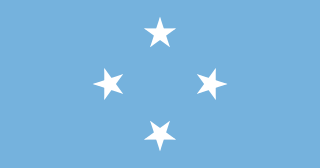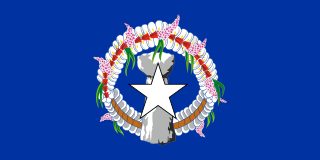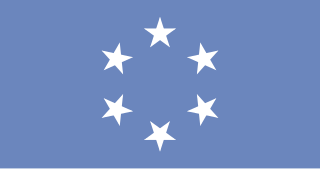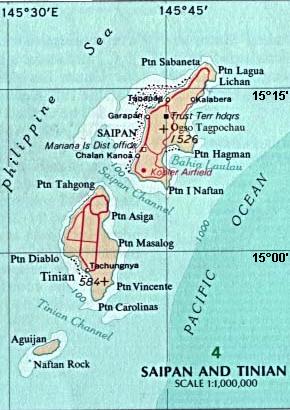Related Research Articles

The Federated States of Micronesia, or simply Micronesia, is an island country in Micronesia, a subregion of Oceania. The federation consists of four states—from west to east, Yap, Chuuk, Pohnpei and Kosrae—that are spread across the western Pacific. Together, the states comprise around 607 islands that cover a longitudinal distance of almost 2,700 km (1,700 mi) just north of the equator. They lie northeast of Indonesia and Papua New Guinea, south of Guam and the Marianas, west of Nauru and the Marshall Islands, east of Palau and the Philippines, about 2,900 km (1,800 mi) north of eastern Australia, 3,400 km (2,100 mi) southeast of Japan, and some 4,000 km (2,485 mi) southwest of the main islands of the Hawaiian Islands.

Guam is an organized, unincorporated territory of the United States in the Micronesia subregion of the western Pacific Ocean. Guam's capital is Hagåtña, and the most populous village is Dededo. It is the westernmost point and territory of the United States, reckoned from the geographic center of the U.S. In Oceania, Guam is the largest and southernmost of the Mariana Islands and the largest island in Micronesia.

Micronesia is a subregion of Oceania, consisting of about 2,000 small islands in the Northwestern Pacific Ocean. It has a close shared cultural history with three other island regions: Maritime Southeast Asia to the west, Polynesia to the east, and Melanesia to the south—as well as with the wider community of Austronesian peoples.

The Northern Mariana Islands, officially the Commonwealth of the Northern Mariana Islands, is an unincorporated territory and commonwealth of the United States consisting of 14 islands in the northwestern Pacific Ocean. The CNMI includes the 14 northernmost islands in the Mariana Archipelago; the southernmost island, Guam, is a separate U.S. territory. The Northern Mariana Islands were listed by the United Nations as a non-self governing territory until 1990.

The Trust Territory of the Pacific Islands (TTPI) was a United Nations trust territory in Micronesia administered by the United States from 1947 to 1994. The Imperial Japanese South Seas Mandate had been seized by the US during the Pacific War, as Japan had administered the territory since the League of Nations gave Japan mandate over the area from Imperial Germany after World War I. However, in the 1930s, Japan left the League of Nations, and then invaded additional lands. During World War II, military control of the islands was disputed, but by the end of the war the islands had come under control of the Allies. The Trust Territory of the Pacific was created to administer the islands as part of the United States, while still under the auspices of the United Nations. Most of the island groups in the territory became independent states, with some degree of ties kept with the United States: the Federated States of Micronesia, Marshall Islands and Palau are today independent states in a Compact of Free Association with the US, while the Northern Mariana Islands remain under US jurisdiction, as an unincorporated territory and commonwealth.

Tinian is one of the three principal islands of the Commonwealth of the Northern Mariana Islands (CNMI). Together with uninhabited neighboring Aguiguan, it forms Tinian Municipality, one of the four constituent municipalities of the Northern Marianas. Tinian's largest village is San Jose. Tinian is just south of the most inhabited island Saipan, but north of the populated Rota to the south. The island is home to many WW2 historical sites, cattle ranches, and beaches. There was a 5-star casino that operated from 1998 to 2015; remaining are other hotels/resorts and a golf course. The main access to Saipan is by a short airplane ride from the international airport, or by a charter boat.

Continental Micronesia, Inc. (CMI) was a Guamanian company which was a wholly owned subsidiary of Continental Airlines. It operated daily flights to Honolulu, Hawaii, as well as international services to Asia, Micronesia and Australia from its base of operations at Antonio B. Won Pat International Airport on Guam, a U.S. territory in the western Pacific Ocean. During its final years, the airline, a Delaware corporation, was headquartered in the old terminal building at Won Pat International Airport in Tamuning, Guam.

The flag of the Federated States of Micronesia was adopted on 30 November 1978. The blue field represents the Pacific Ocean. In an echo of U.S. heraldic practice, the stars represent the four federated states: Chuuk, Pohnpei, Kosrae and Yap, arranged like the points of the compass.
The Micronesians or Micronesian peoples are various closely related ethnic groups native to Micronesia, a region of Oceania in the Pacific Ocean. They are a part of the Austronesian ethnolinguistic group, which has an Urheimat in Taiwan.

Maug consists of a group of three small uninhabited islands. This island group is part of the Northern Islands Municipality of the Commonwealth of the Northern Mariana Islands, itself part of the Marianas archipelago in the Oceanian sub-region of Micronesia.

Asuncion is the third northernmost island in the Northern Mariana Islands chain in the Pacific Ocean. The island is uninhabited. Asuncion is situated 101 kilometers (63 mi) northwest of Agrihan and 37 km (23 mi) southeast of the Maug Islands.

The Northern Mariana Islands national football team represents the Commonwealth of the Northern Mariana Islands in international men's football. The team is controlled by the governing body for football in the Northern Mariana Islands, the Northern Mariana Islands Football Association, which is a member of the East Asian Football Federation (EAFF) and since December 2020 a full member of the Asian Football Confederation (AFC). The association is not a member of the world governing body FIFA, although it had applied for membership, and so while the national team is eligible to enter AFC and EAFF-run competitions, they are currently ineligible for global competitions such as the FIFA World Cup. As such, they do not have an official FIFA ranking. However, the team have been consistently ranked as one of the worst teams in the world on the Elo ratings and were in fact, in July 2016 rated as the worst men's senior international team in the world in a ratings system that also includes a number of other non-FIFA teams.
The Micronesian Games are a quadrennial international multi-sport event within the Micronesian region. The Games were first held in 1969 in Saipan. The 2010 Micronesian Games were initially due to be held in Majuro, until the hosts withdrew. The 2010 Games were hosted by Palau. The Federated States of Micronesia won the bidding to host the 2014 Micronesian Games in Pohnpei State, and later won again against CNMI for the 2018 Micronesian Games, held in Yap State.

The following outline is provided as an overview of and topical guide to the Northern Mariana Islands:

The following is an alphabetical list of articles related to the Commonwealth of the Northern Mariana Islands.

Capitol Hill is a settlement on the island of Saipan in the Northern Mariana Islands. It has a population of just over 1,000. Capitol Hill has been the territory's seat of government since 1962. It lies on the cross-island road between Tanapag and San Vicente.
Tachognya, also known as the Blue Site, is a prehistoric village site on the island of Saipan in the Northern Mariana Islands. It is located near the "Blue Beach" landing site of Allied forces in the Battle of Saipan, from which its name is derived. The site consists of ten latte stone house foundations, the largest of which has twelve latte columns and measures 14 by 58 feet.
Don Allen Farrell is an educator, local historian and author based on the island of Tinian in the Commonwealth of the Northern Mariana Islands (CNMI). He is known for his research and publications on the history of the Mariana Islands with an emphasis on World War II.
The Marianas archipelago of the Northern Pacific contains fourteen islands located between Japan and New Guinea on a north–south axis and Hawaii and the Philippines on an east–west axis. Inhabitants were Spanish nationals from the 16th century until the Spanish–American War of 1898. As Guam became a territory of the United States the Northern Marianas were sold to Germany in 1899. The Northern Mariana Islands were a German protectorate until 1919, when they became part of the South Seas Mandate, administered by Japan. At the close of World War II, the Marianas became part of the Trust Territory of the Pacific Islands. In 1975, the Commonwealth of the Northern Mariana Islands became a self-governing territory. In 1986, the Marianas came under the sovereignty of the United States when the trusteeship ended and US nationality and citizenship was conferred on the inhabitants of the territory.

The Church of Jesus Christ of Latter-day Saints in the Mariana Islands refers to the organization and its members in the Mariana Islands. The Mariana Islands consist of two jurisdictions of the United States: the Commonwealth of the Northern Mariana Islands and, at the southern end of the chain, the territory of Guam. As of December 31, 2022, the LDS Church reported 2,547 members in one stake, five congregations, one mission, and one temple in Guam. There are 906 members in a ward in the Northern Mariana Islands. There are two family history centers, one in Guam and one at the Saipan Ward building in the Northern Mariana Islands.
References
- ↑ Bendure, G. & Friary, N. (1988). Micronesia:A travel survival kit. South Yarra, VIC: Lonely Planet.
- ↑ "Proclamation 5564—United States Relations With the Northern Mariana Islands, Micronesia, and the Marshall Islands". The American Presidency Project. Retrieved September 1, 2019.